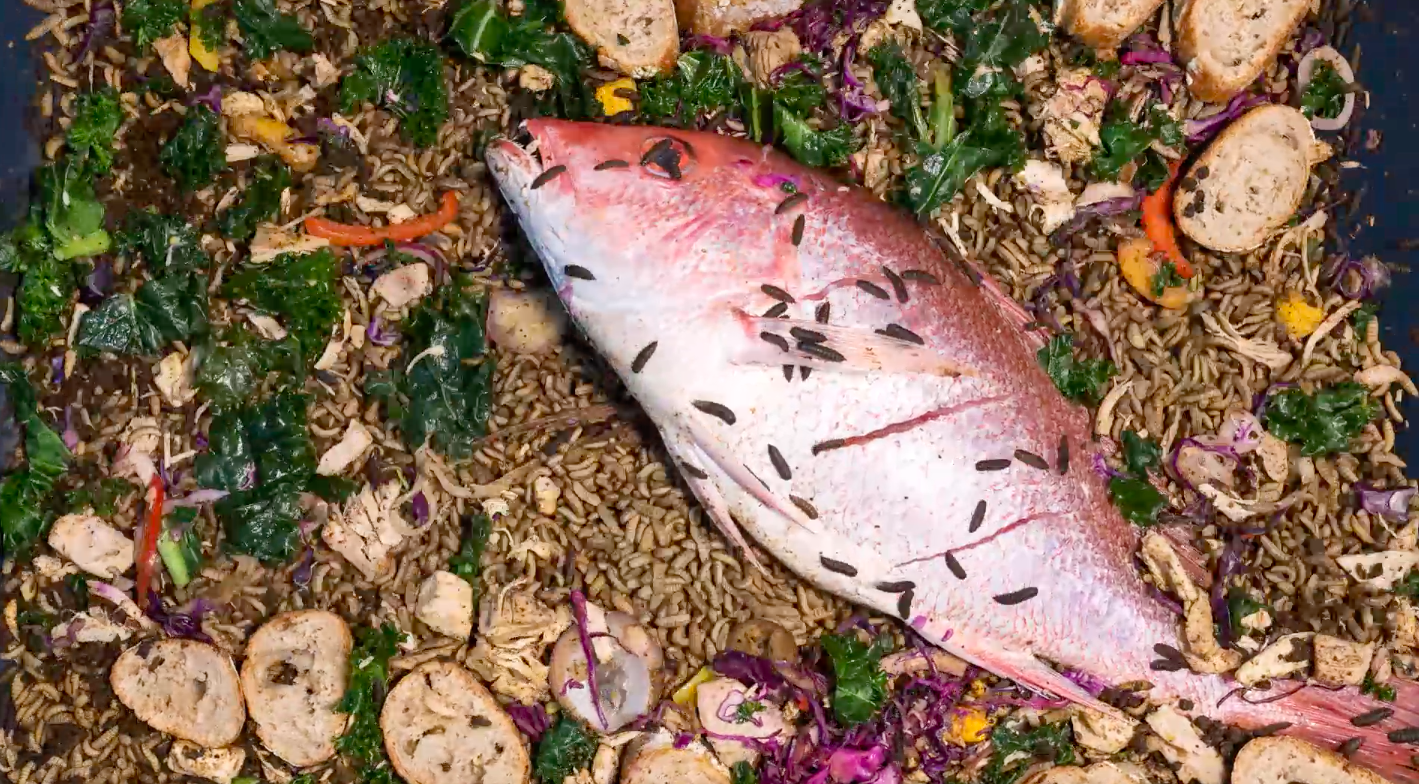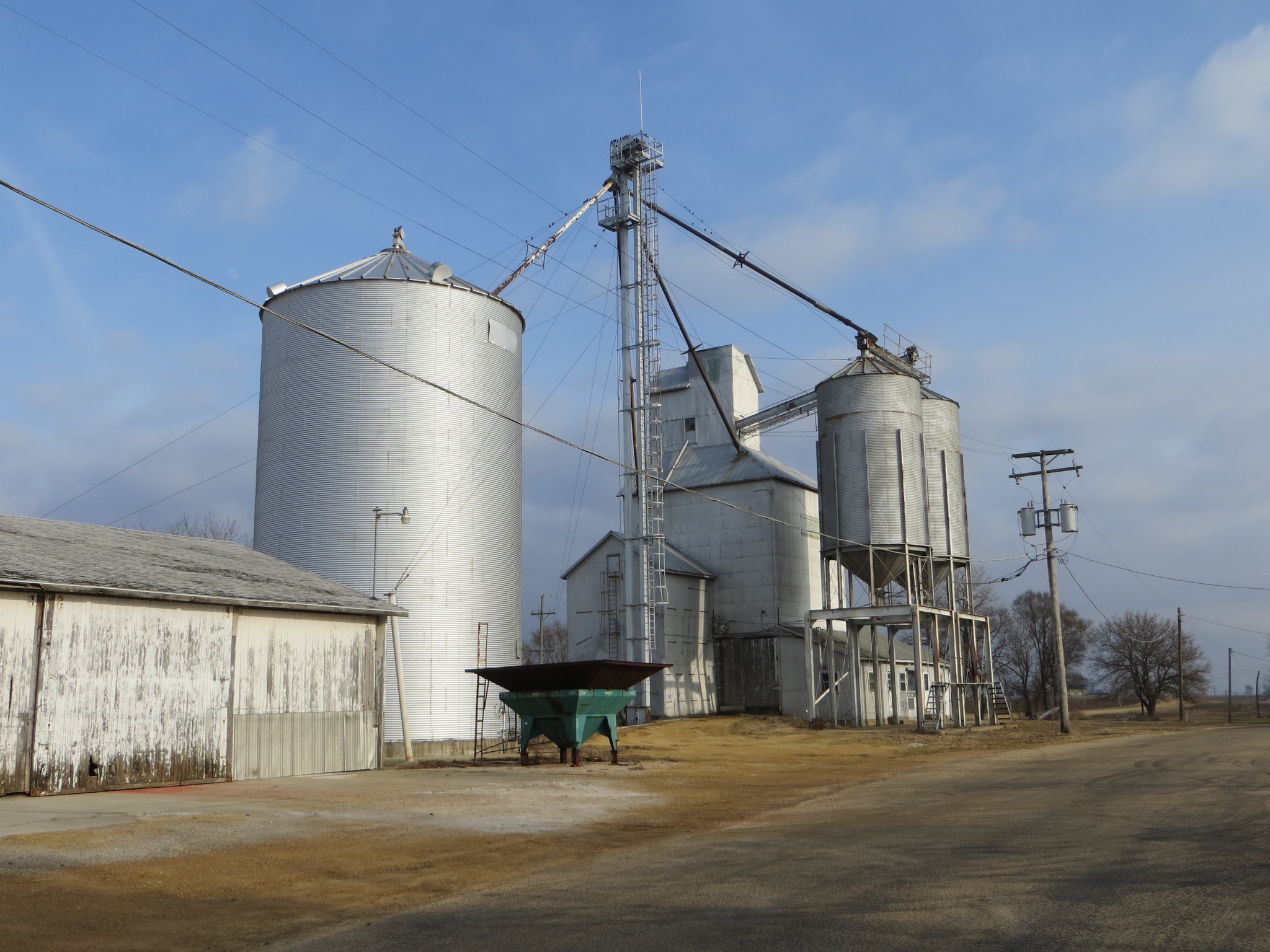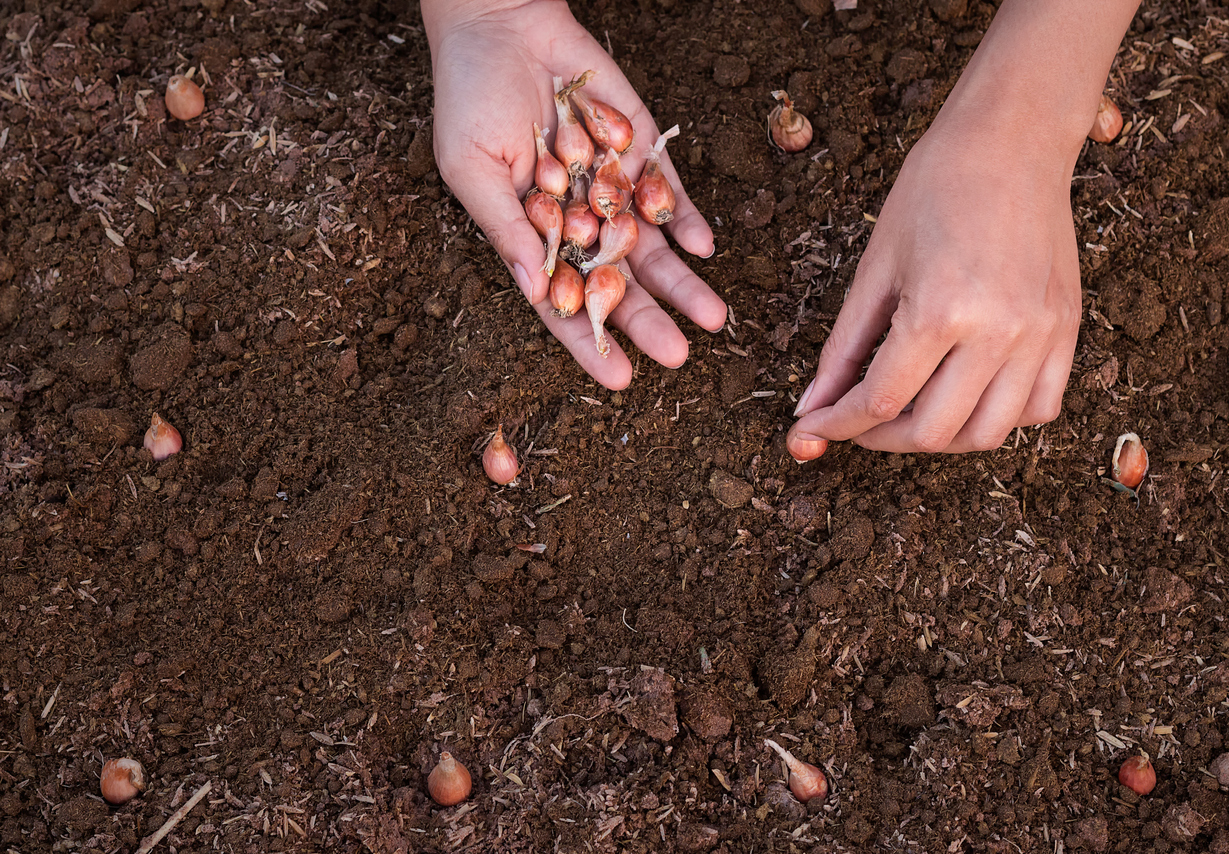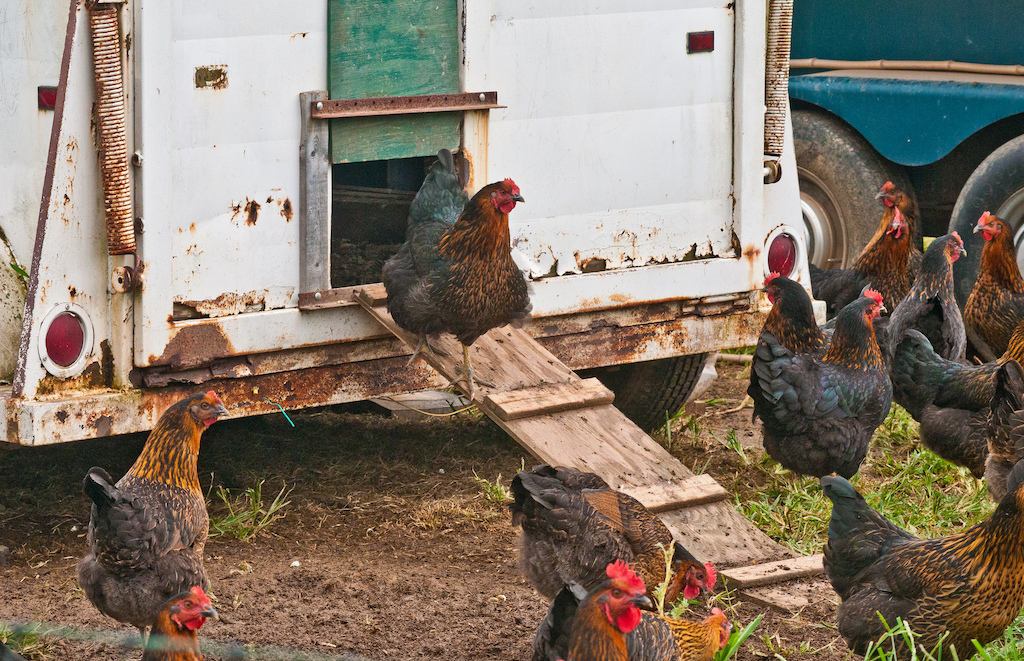
Gloria Dickie
Phil Taylor carefully slides back the corrugated plastic door on his 1,800-square-foot barn, on the outskirts of Boulder, Colorado. To the west, the foothills of the Rocky Mountains loom large above the laying hens that peck and scratch in the dusty field. “The smell in here isn’t too bad,” Taylor observes, stepping inside, as the aroma of warm earth, yeast, and old ginger surrounds us. He strolls over to a series of wooden shelves housing dozens of black, nine-gallon Rubbermaid mixing tubs and begins combing his hands through their contents. “I mean, I wouldn’t want to smell this all day, but it’s not putrid.” One by one, pale, wriggling maggots, immersed in wasted brewers grains, begin to trickle through his tanned fingers. Suddenly it seems all too important that this disquieting sight isn’t also accompanied by the smell of rotting decay.
Unlike their crunchy cricket counterparts that star in the “edible insect” movement, these maggots aren’t intended to reach the public’s plates anytime soon. (Though they are safe for humans to eat.) They’re the larval stage of black soldier flies (Hermetia illucens), a common fly found primarily in bright, sunlit, vegetated areas. Unlike house flies, black soldier flies don’t spread disease. (They live only a few days after hatching, and only their larvae feed.) They also look different, with longer bodies, and a narrow waist that gives them a wasp-like appearance. Taylor, a 34-year-old ecologist at the University of Colorado Boulder, is part of a small group of intrepid entrepreneurs around the world, from Ohio to South Africa to the Netherlands, who are attempting to rear black soldier flies in hopes of revolutionizing the global animal feed industry.
“There’s this conundrum in the feed market as to what is the future of protein,” says Taylor, his long sun-bleached brown hair tied into a messy ponytail and swept underneath a custom-designed trucker hat featuring a blueback herring. The UN Food and Agriculture Organization estimates that global commercial livestock feed production, currently around 959 million tons per year, will have to increase by 70 percent by 2050, with meat outputs expected to double. Right now, most protein produced to nourish livestock comes from soybeans and fishmeal. But the former is relatively low in protein and requires vast swaths of land to produce—which has caused massive deforestation, especially in the Amazon. Fishmeal, sourced from small, wild forage fish, like herring, Peruvian anchoveta, and menhaden, has a different problem: It’s a finite supply—and demand has already pushed stocks close to collapse. This year, following a population decline of more than 90 percent since 2007, the U.S. banned sardine fishing along the West Coast for the second straight year.
For many agricultural producers and researchers, black soldier fly larvae are the natural solution. They’re native to North America and already thrive across most of the temperate world; they’re high in crude protein (about 40 to 44 percent); they require little land and greatly reduced energy inputs compared to soy and fishmeal; and they can be grown and harvested in two weeks or less. Not only do they help to solve protein shortages, but they’re raised on a diet of food waste. “One of the biggest challenges in rehabilitating the modern food system is figuring out how to move away from a linear farming system and create a circular structure,” explains Taylor. “It takes a lot of effort to determine how to recycle nutrients, and black soldier flies could be the solution.”
~
Inside Taylor’s dirt-floor barn, the mechanisms of maggot production are laid bare. With the values of a salt-of-the-earth farmer and the mindset of a Silicon Valley innovator, Taylor has opted for an open-source, patent-free approach to bugs, in hopes of spurring faster, widespread adoption. Every one of his plastic bins starts with three grams of fly eggs, around 40,000 individuals, each smaller than the eye of a needle. In three to four days, those eggs will hatch into tiny, 2-millimeter larvae that, when fed on a steady diet of 75 pounds of food waste, will grow 8,000- to 10,000-fold over the next 10 days, to about three-quarters of an inch. At the two-week mark, when they’ve reached their maximum nutritional value, and shortly before pupation (the life stage when a larva transforms into its winged, adult form), 90 percent will be harvested. This involves Taylor and his team moving the live larvae into ovens to kill them. The other 10 percent—the lucky ones—will be moved to a screened-in, temperature- and humidity-controlled breeding chamber, where they pupate, mate, lay eggs, and then die naturally.
 Gloria Dickie
Gloria Dickie On a warm September day, Phil Taylor waters the makeshift gardens outside his new black soldier fly greenhouse. He’s in the process of raising $850,000 from investors to move into a 20,000-square-foot facility
When I first met Taylor in January 2015, he was carrying around a mason jar filled with maggots, surreptitiously scraping lunch leftovers into the writhing mass. At that time, he believed etymology was every bit as important as entomology in determining whether or not black soldier fly larvae would be able to appeal to a mass market. “Maggots” just wasn’t a palatable sell to end-of-the-line consumers. Since then, he says he’s grown more comfortable with it, no longer restricting himself to “bugs” or “larvae”. To farmers, he says, “the idea of insects is a no-brainer. That’s what trout eat. That’s what chickens eat. Feeding chickens a fish out of the ocean, or giving fish soybeans, is actually what’s weird.”
Regardless of marketing, the global agricultural industry may not have much of a choice in the near future. Livestock feed is a $460 billion industry, and feed comprises 60 to 70 percent of livestock and poultry production costs. Producers expect those feed sources to become more stressed in the future.
Seventy percent of all agricultural land goes toward livestock production, and 30 percent of all grains grown are fed to animals. For soybeans, that number hits 80 percent. Soy is almost always grown in large monocultures, and it requires tremendous chemical inputs. Meanwhile, aquaculture is the fastest growing agricultural sector on the planet, and that comes with its own set of astronomical challenges. For years, Richard Waite at the World Resources Institute has been investigating how to sustainably feed 10 billion people by 2050. “As we realized just how much extra fish the world is going to demand—essentially doubling—we began looking into how we can make sure it’s as sustainable as possible,” he says. “We’re not going to get much more wild fish, so that gap in increased fish demand needs to be met by aquaculture.”
In recent months, Taylor and the industry at large have begun to clear hurdles. Last summer, the Vancouver-based bug farm Enterra received approval from the Canadian Food Inspection Agency to use farmed maggots as chicken feed—the first time a federal regulatory body in North America has allowed the sale of insect ingredients as animal feed. Meanwhile, Enterra’s application for fish feed is awaiting a green light; and in the United States, one of the largest larvae companies expects to obtain federal approval for use of its products to feed salmonids (which includes trout, char, and graylings) within the year. As governments, farmers, and producers begin buying into the idea of feeding larvae to livestock, a singular question emerges: How do we make this trend global?
~
Yellow Springs, Ohio, is a 3,500-person town surrounded by thousands of acres of soybean fields: The state’s top crop brings in more than $2 billion annually. Nearly a third of all land in Ohio goes toward soybean and corn production. But despite being situated firmly in the agricultural heart of Middle America, Yellow Springs, locals say, is “a bit out there.” Last November, 89 percent of Yellow Springs voters threw their weight behind Hillary Clinton—a stark contrast to the Trump-Pence signs that blanketed the surrounding countryside when I passed through in late October. For Glen Courtright, known by his neighbors simply as “The Bug Guy,” it’s exactly the kind of liberal crowd he could count on to accept a commercial-scale maggot farm in their backyard.
 Gloria Dickie
Gloria Dickie Adult black soldier flies procreate in one of the experimental breeding areas inside EnviroFlight’s Ohio factory
In many ways, Courtright is Taylor’s antithesis. A straight-laced, methodical former military man bent on meticulous standards, Courtright was one of the first players to enter the black soldier fly game back in 2009 with his company, EnviroFlight. While providing engineering advice for an oil company client on the North Slope of Alaska 10 years ago, he was struck by the rapidly warming climate, which had shortened ice-road season. Courtright was compelled to act, dabbling first in biodiesel—too risky, he concluded—before deciding he’d rather feed the planet than power it. Today, his 20,000-square-foot operation spans several offices, greenhouses, and industrial buildings mere blocks from Yellow Springs’ quaint downtown—and he’s looking to expand. Last spring, the company was acquired by Intrexon, a corporate giant in the realm of synthetic biology.
It’s been a long road for Courtright to get his flies off the ground. The beginner large-scale prototypes he built would initially work, and then suddenly fail. “We’d get close again, and they’d fail.” Each failure resulted in mass deaths of insect larvae, which Courtright describes as a “rather unpleasant, odiferous experience.”
Even once Courtright pinned down the right living conditions, he needed to figure out how to get the soldier flies to breed under artificial lighting, to enable year-round production. For months, Courtright, who has a background in electrical engineering, tinkered with different wavelengths of light to solve the problem. “I’ve probably got the biggest lightbulb collection on the planet now,” he says. Then, in December 2010, one week before the winter solstice in the middle of a fierce snowstorm, he had a breakthrough. He flipped the switch in the greenhouse dubbed “Love Shack 1,” and the flies began going at it. He had finally created the perfect combination of light, humidity, and temperature, simulating “a sultry summer day in Georgia.” (Though he won’t reveal the exact formula.) From then on, everything was about optimizing and figuring out how to scale up operations for global commercial production.
At the end of the line (where our tour starts), the larvae are funneled into a giant dryer, which runs 16 hours a day. Once the larvae are dried, some have the oil in their tissues extracted and the solids are ground down into a fine powder, while others remain in their larval form and are packed into large barrels. The factory is far warmer than the hallways that connect each stage of production, and it smells overwhelmingly of fresh yeast—the primary notes of the bugs’ buffet. Courtright’s business is one built on trade secrets, patents, and intellectual property; as we move through the facility, he seems to weigh in his mind which pieces of the process he can reveal.
We pass through the first phase of the nursery, through rows of plastic and stainless steel bins housing the tiniest of larvae (they’re reared on different food than their older siblings, but Courtright won’t say what), then to the receiving facility, where semi-trucks deliver giant, white sacks of food waste every other day, sourced from around the region. Finally we arrive at the “kitchen,” where employees churn the waste into sludgy porridge. “You’re going to see some things that will potentially start blowing your mind,” Courtright tells me, as we come to a stop in front of a semi-opaque plastic curtain.
We enter a cavernous room, where metal towers—skyscrapers of mature maggots—stretch toward the high ceiling. If you listen carefully enough, you can hear them squirming—a shaky slithering sound as the larvae chow down. Every bin, identified by its own unique address in this bizarre cityscape, holds more than 100,000 larvae that together can process up to 3.5 tons of food waste each year. Courtright starts crunching the numbers—mental math is a strong suit. In a 2-foot by 4-foot space, he’s getting an astounding 400 kilograms of dried bugs per year. “But if we really want to talk about yields, come over to the hatchery.”
 Gloria Dickie
Gloria Dickie Millions of larvae at the large-scale EnviroFlight factory are fed on a steady diet of cookie meal—pre-consumer bakery residue that is dried so that it won’t spoil
In the corner, Courtright has set up a small research and development space where he can continue to experiment on insect-rearing techniques. Each screened cage, where thousands of adult black soldier flies mill about (some already in clusters trying to mount each other), measures about one cubic meter. The flies will lay up to 20 grams of eggs—just under a million individuals—per day in each cage, and when that brood reaches full size (up to 10,000 times larger) in their feeding bins just two weeks later, it will be the equivalent of one 440-pound live animal.
“We’ve truly created something phenomenal here,” Courtright concludes with pride.
Back in the office, after we’ve been doused with a long spritz of Febreeze to remove the yeasty odor that permeates our clothing, Courtright reclines in his black leather chair to ponder the future. A framed article knighting him as the “Lord of the Flies” hangs on the wall. Unlike Taylor, who has looked primarily at feeding chickens, Courtright’s initial focus has been on aquaculture. In Ohio, the dried larvae are currently approved at the state level for use in salmonids, allowing them to run research trials at this point, but he expects to receive federal approval to sell to fish farmers around the country within a year.
“I still think we’re in the Model A stage,” Courtright says. “The basic car is running, we understand the mechanics, and the best thing for this to really take off is to get this in the hands of other engineers and scientists. We need to start building out the collective technology.”
Right now, his focus is primarily domestic. But he hopes his “encore career” will one day take him overseas, ideally to address the humanitarian component of what he’s created—in Africa, in Asia—free from the restraints of corporate capitalism, and the need for return on investment.
“We can make this thing work anywhere in the world now. We could run it in the Arctic if we had to. Not a problem.” He pauses for reconsideration. “Well, I guess we would have to be able to get the feedstock up there. There’s not a lot to eat.”
~
Forty percent of food in the United States is wasted. That’s more than 20 pounds of food per person, every month, going uneaten. And almost all of that food ends up rotting in landfills, where it accounts for 16 percent of U.S. methane emissions. Black soldier flies are attractive to producers not only because they help solve the protein puzzle, but because they bolster nutrient recovery, patching critical holes in the global food system.
Right now, companies are primarily focused on pre-consumer food waste. That means they’re not looking for kitchen scraps, but rather what’s wasted from farms and industrial production. For Taylor, that translates into getting a large tub of ginger shavings, chard, and carrot scrapings from Wonder Press juicers in Boulder every other day. While local farmers have long had dibs on much of the waste in Boulder County, livestock can be pretty choosy, he explains.
“No one likes ginger, so we get all of this. When the bugs digest this stuff, the whole greenhouse smells like ginger,” he says, tossing up a spicy cloud of shavings.
In his production line, the waste is then transferred to a large five-gallon drum where Rojas uses lactobacillus, the same bacteria found in yogurt, to ferment the leftover veggies. By pre-fermenting the feed, they’re able to preserve the waste and build up their food reserves without the risk of expiration before the larvae are plentiful and mature enough to eat all of it, Taylor explains while hoisting the new, filled barrel into his car.
 Gloria Dickie
Gloria Dickie Black soldier fly larvae process different types of foods at different rates. Bakery products are consumed quickly, while fish skin and bones take much longer
In Yellow Springs, Courtright has taken another approach. He feeds his bugs “cookie meal,” which is essentially bakery residue—expired breads, cookies, and crackers that give the factory its yeasty smell. When Intrexon purchased EnviroFlight this spring, they formed a partnership with Darling Ingredients, a large-scale producer and developer that collects these scraps and turns them into the dry Cookie Meal. “More and more [bakery residue] is coming online, and it makes a very good source of material for us because it has a stable shelf life,” Courtright says.” That means that instead of having decomposing yeasty material dropped off at the factory, EnviroFlight only has to take shipments of dry, stale yeast byproducts.
~
Getting insect-based feeds into the mass market will ultimately be as much a matter of economics as of technological innovation and intestinal fortitude.
Rick Barrows is an animal nutritionist who has spent 15 years at the USDA’s Agricultural Research Service, developing and evaluating alternative feed for salmon and other species. For aquaculture, fish need the right balance of protein and fish oil; the latter can be accomplished to a degree with insects, by feeding them fish-processing waste, Barrows discovered. He has tested both EnviroFlight and Enterra’s black soldier fly products.
“Insects are a highly digestible energy and protein source,” he says. Black soldier fly larvae ring in at around 50 percent protein, much better than soy but lower than high-quality fishmeal at 70 percent protein. For livestock producers, the real challenge isn’t so much nutrition as it is cost.
Eventually, the price of fishmeal will surpass the price of mass-produced insects, at which point market forces will kick in and bring the cost of insects down even further. And if demand has a role to play, that point could come sooner than most producers and investors anticipate.
Shortly before Halloween, I venture out to McCauley Family Farms in Longmont, Colorado. It’s a boutique, sustainability-focused farm that serves a niche, upper-end market in Denver and the rapidly urbanizing Front Range, along the Rocky Mountain foothills. It’s the kind of place that hosts farm-to-table dinners and whose broiler chickens sell for $27 at nearby restaurants. When I arrive at the main office, employees are toying around with a bucket of crawdads, having just drained the farm’s lake for the season.
Running a small-scale operation, Marcus McCauley is all too familiar with the struggle to source environmentally friendly yet economical feed. His 6,000 broiler chickens are fed non-GMO corn and soy grown in Colorado, while his laying hens (eggs sell for $10 per dozen) are fed on a certified organic fishmeal from Nebraska. “We just aren’t able to get cheap organic feed for broilers. I’m constantly trying to find the best solution, ecological and economical, for our system here,” he explains as we walk past the green-speckled pasture that held 1,500 birds up until they were sent to the slaughterhouse last week.
After meeting Phil Taylor at a farm dinner last year, McCauley started pondering the potential for maggots in his production line. Already, about 30 percent of his pasture-fed chickens’ diet comes from bugs the birds find out in the fields. “I was really excited.” But until the United States grants federal approval to feed insect-based products to publicly sold broiler chickens, McCauley will have to wait.
 Gloria Dickie
Gloria Dickie McCauley Family Farms in Longmont, Colorado, raises about 6,000 broiler chickens each year. Because of their pricy feed, the eggs of the laying hens (pictured) sell for about $10 per dozen
“We can’t grow near enough [pasture-fed chickens] for what the demand is. People are becoming more and more aware of what they put in their bodies, and this protein piece is new. You’re no longer just what you eat. You are what you eat eats.”
~
There’s no one-size-fits-all approach to farming black soldier flies. Decentralized back-of-factory set-ups can work—so can backyard larval composting pits and maggot gigafactories. But due to high start-up costs, most entrepreneurs are tackling the protein shortage via the latter. EnviroFlight is searching for a new large-scale facility in the Ohio-Kentucky area, expecting to make an announcement any day now. Vancouver-based Enterra’s factory swiftly went under construction following the government approval this summer. And even Taylor, who views himself as more decentralized, is looking to raise $850,000 from investors over the next few months to move into a 20,000 square-foot facility along the Front Range.
But the quest to rear the next big thing in agriculture lives alongside a healthy dose of environmentalism and humanitarian interest. In our final conversation, I ask Taylor, a Maryland native, about the blueback herring hat I’ve rarely seen him without.
“The waters are empty compared to what they use to be,” he continues. “We’ve removed a central cog from the coastal ecosystem. We can no longer expect to harvest those things like we’ve done without seriously wreaking havoc.”
For Taylor, the solution is obtaining protein from diverse, natural, commonsense sources, of which bugs are a mainstay—not depleting our oceans to feed fish to chickens. And putting waste back into the food cycle—not letting leftovers rot in landfills. “If maggots even just touch the demand for soy and fish, it’s a hugely viable business. All the meat we sell is built on those sources of protein. And they’re completely unsustainable. Something’s gotta give.”
This story originally appeared in bioGraphic, an online magazine about nature and sustainability powered by the California Academy of Sciences.










